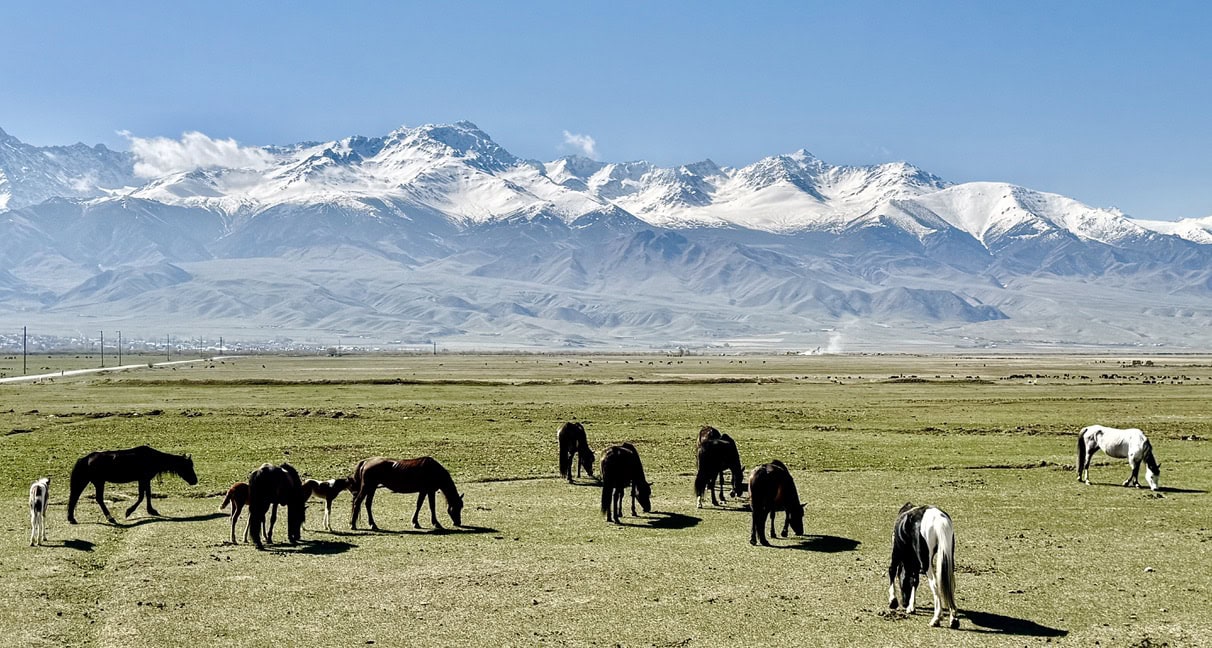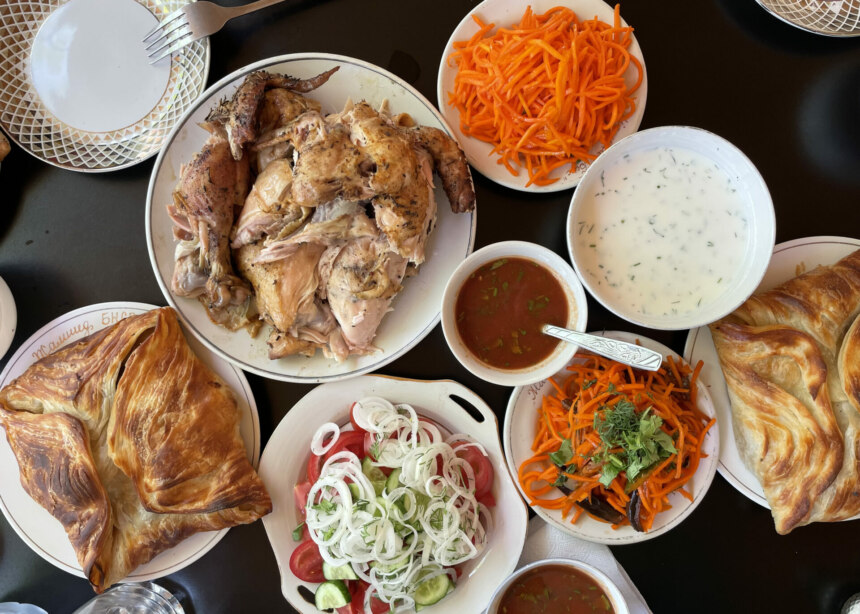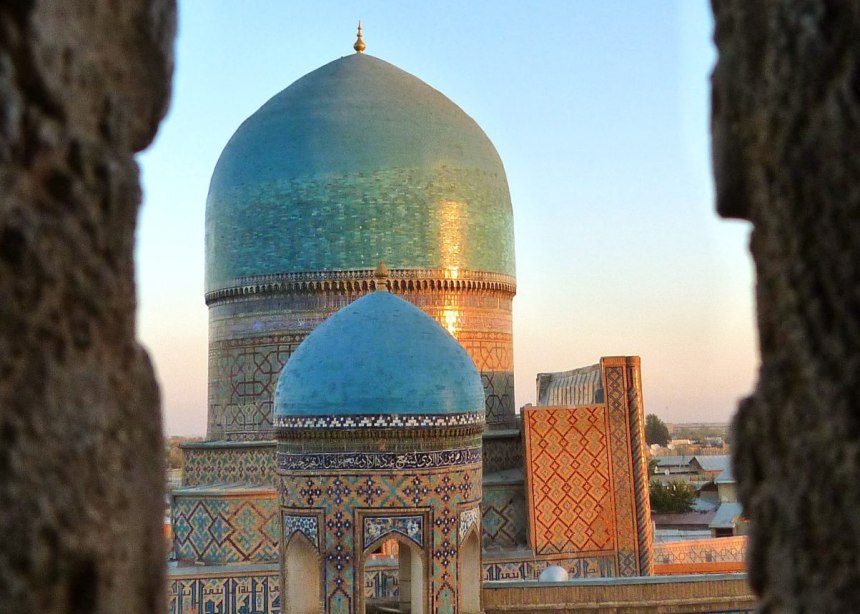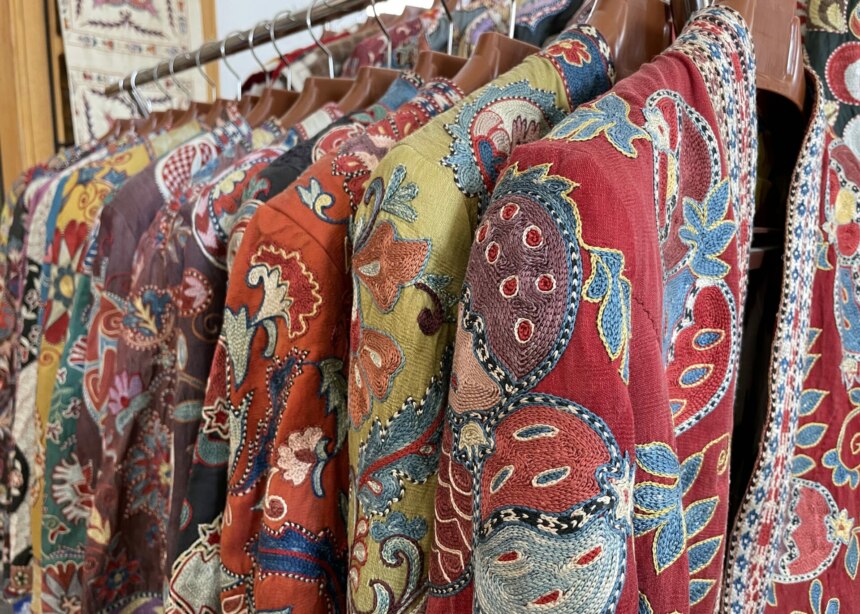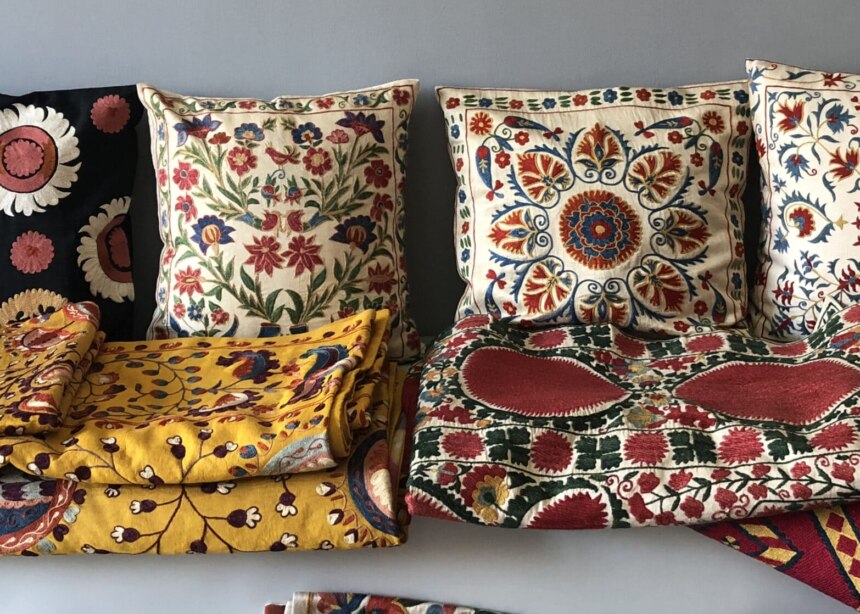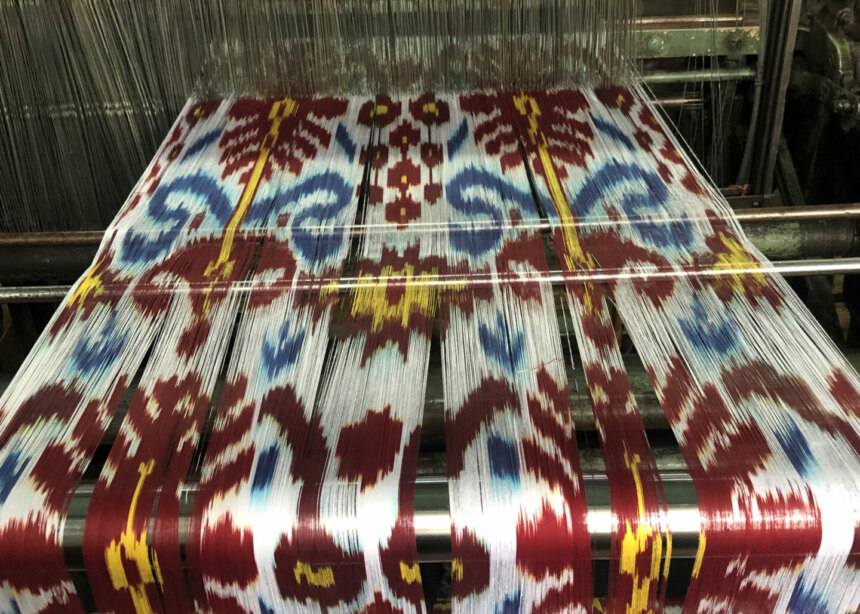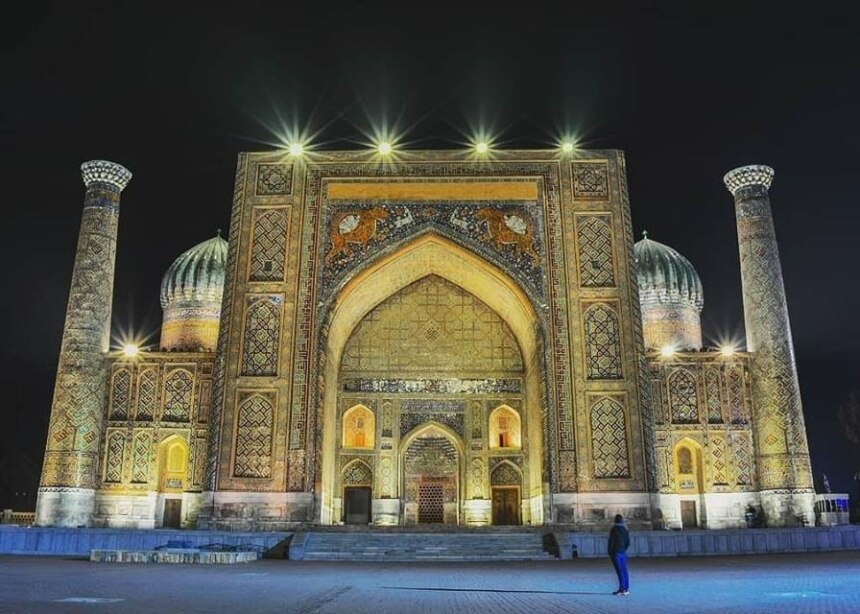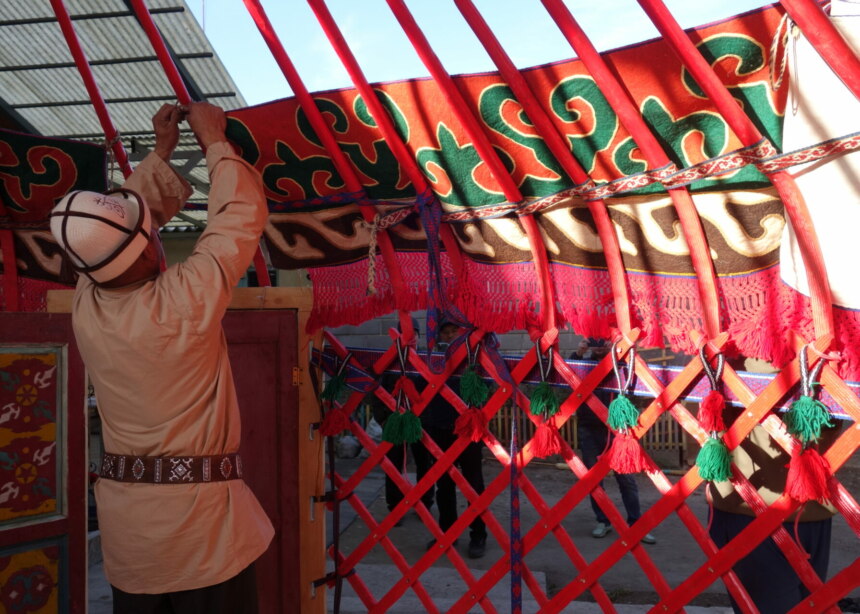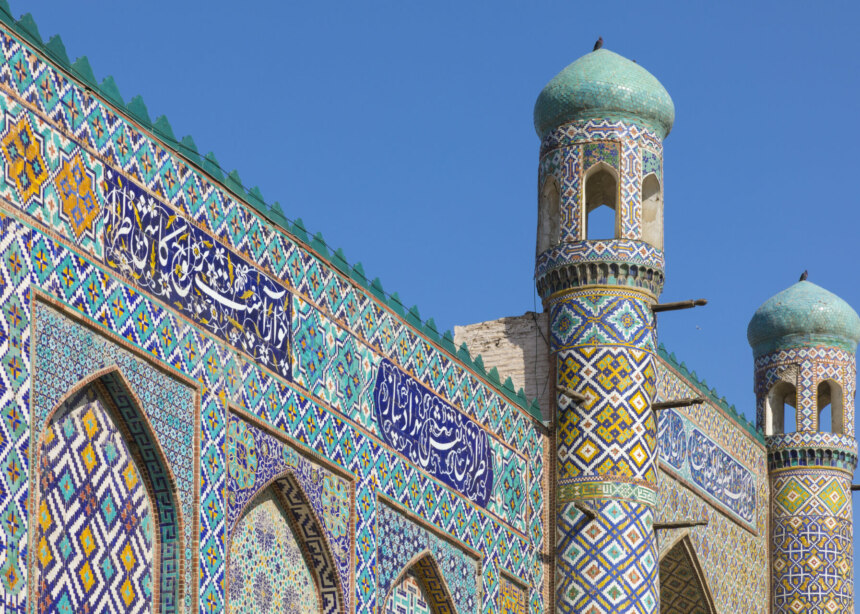Our 24-night textiles and arts tour of Uzbekistan and Kyrgyzstan checks another fabulous adventure off your bucket list!
On this spectacular tour, we’ll be following the Silk Road, the ancient network of trade routes that linked the Mediterranean and China. Age-old artistic exchanges and shared aesthetic traditions practically assured that nowadays the whole region would be home to large numbers of talented artisans. Uzbek and Kyrgyz textile artists create exquisite hand-embroidered suzanis, brilliant hand-dyed, handwoven ikat fabrics and innovative felted rugs. In both countries, we will meet these welcoming people and see their weaving, dyeing and felting techniques first-hand.
In the historic areas of many Uzbek cities such as Samarkand and Bukhara, blue and turquoise-domed mosques and madrasas compose important UNESCO World Heritage sites. Detailed tile mosaics with masterful calligraphic panels decorate these stunning ancient buildings inside and out.
Bishkek, the Kyrgyz capital, has modern hotels, tree-lined streets and verdant parks. The restaurants of both countries are superb, offering traditional dishes and a great variety of fresh, healthy foods.
TRIP HIGHLIGHTS
- Visit exquisite blue-tiled madrasas, mosaic-covered mosques, and fascinating museums
- Shop in the bustling markets and handicraft bazaars of Bishkek and Toshkent
- Meet silk ikat dyers and weavers, and embroidery and ceramic masters
- Meet Kyrgyz feltmakers and learn their methods of making cozy shyrdak rugs
- Walk historical neighborhoods of ancient Samarkand and Bukhara to see UNESCO Heritage sites like Registan
- See the ancient Tosh-Rabat stone caravanserai in the Tien Shan Mountains.
What’s Included in The Trip?
An Overview of Your Journey
Historical Tashkent
The trip begins in the beautiful city of Tashkent, the Uzbek capital. You will be met at the airport and transported to our hotel. Depending on what time you arrive, you’ll sleep or relax until time for breakfast, then go out with us to explore markets and mosques on this first day in Tashkent. The capital city is known for its many museums and its mix of modern and Soviet-era architecture. Big sycamores line the wide avenues and mosaic-decorated apartment blocks alternate with sleek new glass and steel edifices. The Soviet-era Metro stations are stunning and we will take a ride to see some of the artistic masterpieces underground.
In Tashkent’s old city, we’ll admire historical buildings with iconic turquoise-tiled domes, such as the 16th Barak-Khan Madrasa complex. It is famous for the intricate mosaic tile work on the buildings. We’ll also visit the home studio of a famous embroiderer. She will show us her working methods with hand-dyed silk threads, and we’ll also have a chance to see her beautiful suzanis, coats, and jackets.
We’ll visit the Museum of Applied Arts which showcases some of the best historical examples of the arts of Uzbekistan. The Russian diplomat Alexander Polovtsev commissioned the intricately decorated mansion expressly to display his vintage folk art collections of ceramics, folk instruments, rugs, ikat examples, and suzanis.
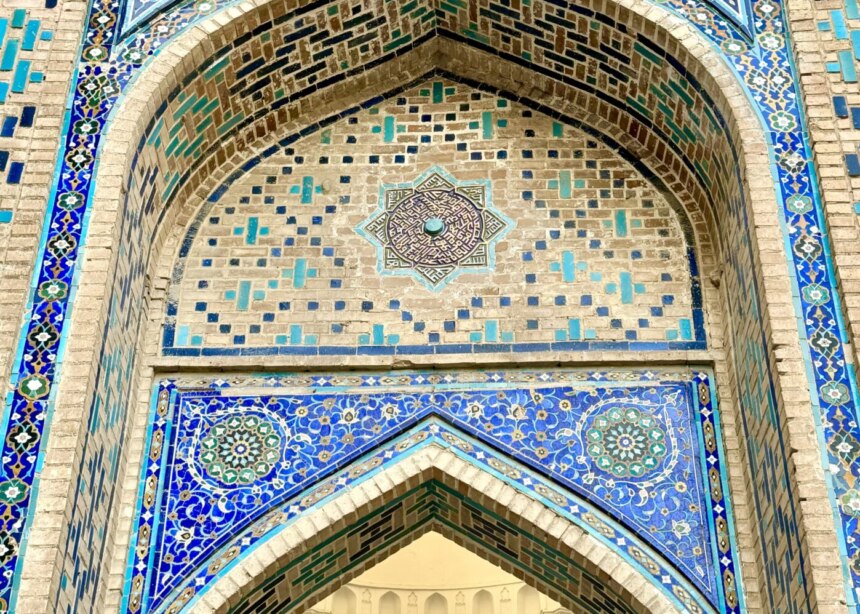
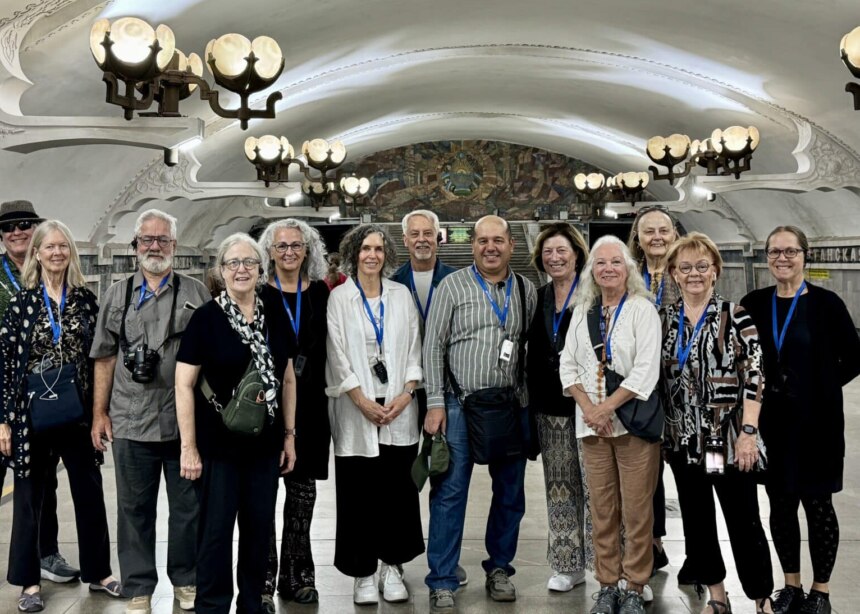
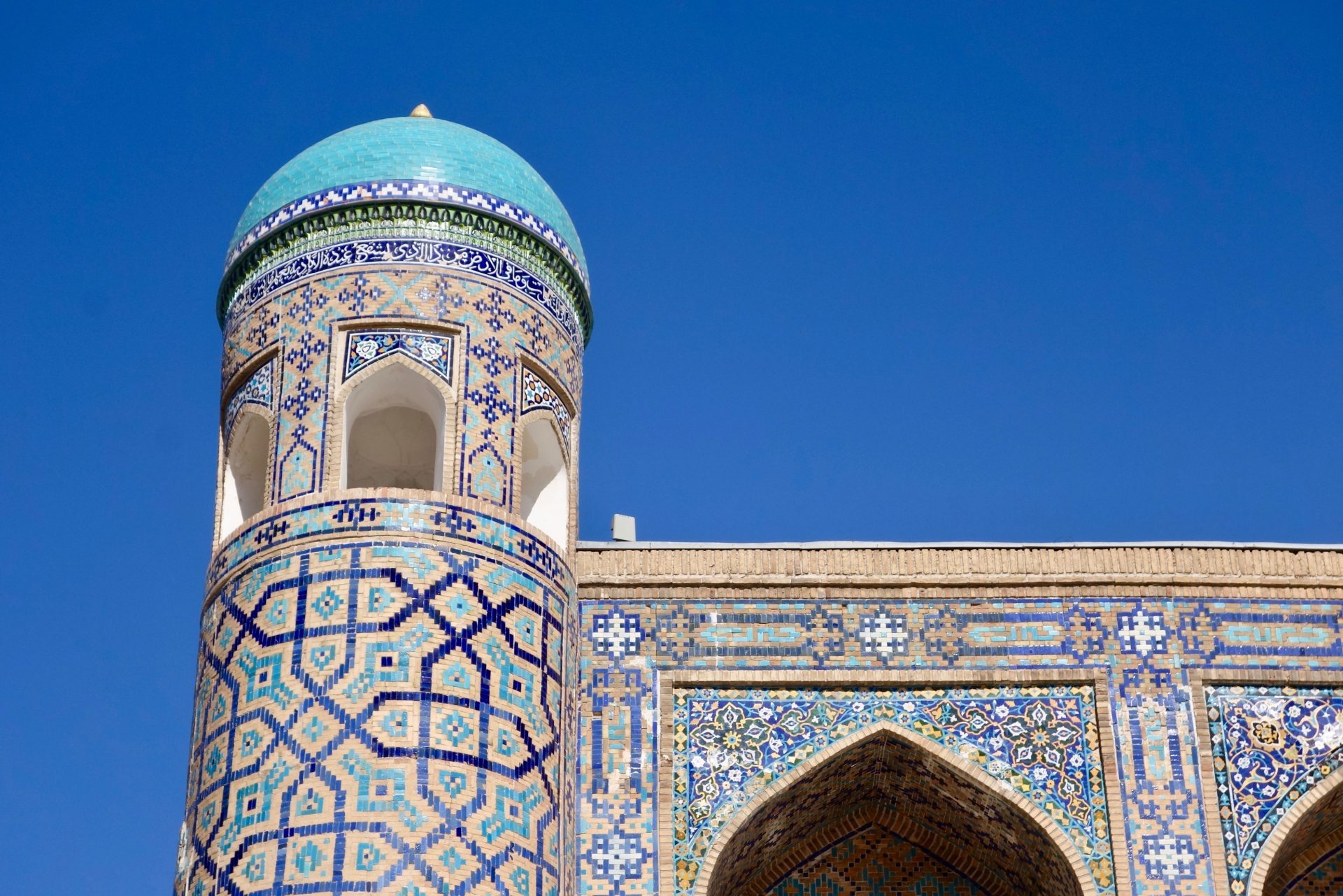
All aboard for Samarkand!
From Tashkent we board the air-conditioned fast train to Samarkand. Seasoned travelers consider Samarkand as one of the most beautiful cities in the world, not only for the stunning historical monuments but also for the tree-shaded avenues and lovely green city parks. It was an important trade stop along the Silk Road and was at the forefront of early Islamic architecture.
We’ll visit a carpet workshop, the Afrosiab museum and the fascinating Observatory of visionary astronomer, Ulughbek. We’ll see the towering tomb of Emir Timur (Tamerlane), founder of the Timurid Empire. Prominent landmarks include the iconic Registan, a plaza bordered by three ornate, tile-covered madrasas dating to the 15th and 17th centuries. The fabulous Registan Square is lit with floodlights at night and looks magical.
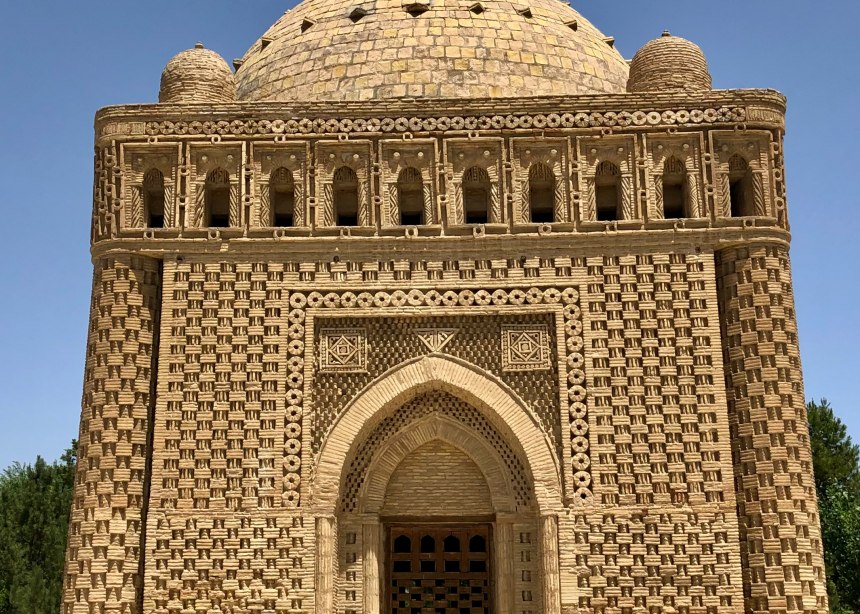
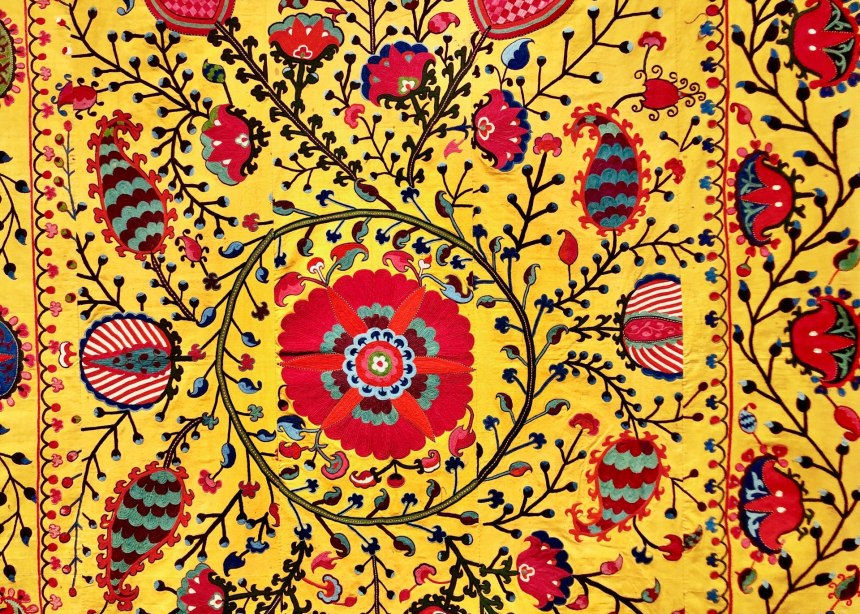
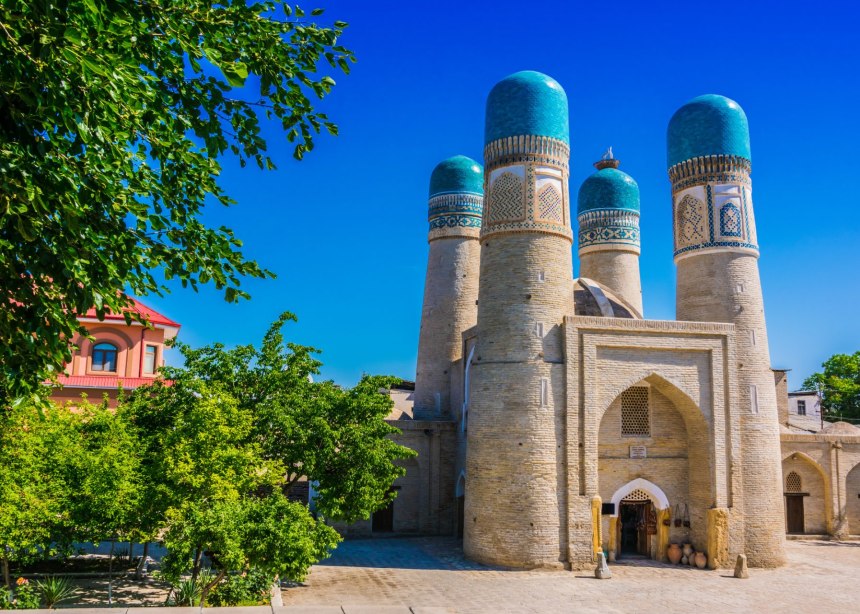
Next Stop Bukhara!
Next we’ll visit the ancient city of Bukhara, a UNESCO World Heritage site that is more than 2,000 years old. It was a prominent stop on the Silk Road trade route between the East and the West, and a major medieval center for Islamic theology and culture. It still contains hundreds of well-preserved mosques, madrasas, bazaars and caravanserais, dating largely from the 9th to the 17th centuries. Monuments of particular interest include the famous tomb of Ismail Samani. It’s a masterpiece of 9th -10th-century Muslim architecture partly because of the variety of patterns executed in unglazed fired brick. Blue mosques and textile bazaars also abound in this fabulous historical city. Bukhara is one of the best places to explore the architecture and textiles of Uzbekistan.
The age-old caravanserai and madrasas in Bukhara have often been converted into artists’ studios and workshops. And several ancient, domed bazaars here offer carpets, suzanis (left), and jewelry. We’ll explore these as well as an artisan center where we can learn how typical crafts are made. We know many artisans and collectors that we can visit, so you will have a first-hand chance to see some exquisite textile masterpieces.
While in Bukhara, we’ll see the Emir’s summer palace, Sitorai Mohi Hosa. Built in 1911, the palace now houses the excellent Bukhara Museum of Decorative Arts where the superb suzani collection will enthrall embroidery lovers.
On to Khiva!
Onward from Bukhara to Khiva! This is a long drive, but the desert landscape is compelling: vast steppes, shepherds and their flocks, remote villages, military outposts and unusual vegetation. We’ll skirt the Kyzylkum or Red Sand Desert, to see Khiva’s wondrous architecture and carpet knotters. We’ll cross the Amu Darya River, long ago known as the Oxus.
Ichan Kala is the UNESCO site walled, ancient, inner city of Khiva, considered to be the largest surviving walled city in central Asia. An important stop on the ancient Silk Road, the inner city was protected by 10-meter high brick walls. It was the last resting place of camel caravans before crossing the desert to Iran. Although few very old monuments remain, it is a coherent and well-preserved example of the Muslim architecture of Central Asia. Tiled and mosaic-encrusted treasures of Khiva’s old town include stunning palaces, mosques, and minarets.
Embroidered textiles and fluffy sheepskin wool caps abound in Khiva. We’ll visit several grand architectural wonders and have dinner on a rooftop with 360-degree views of nighttime illuminated Khiva. In a Khiva carpet shop, several women are at work on beautiful woolen carpets. Hand-knotted examples here show unusual patterns that were inspired by the designs of the tiles and carved wooden doors of the city.
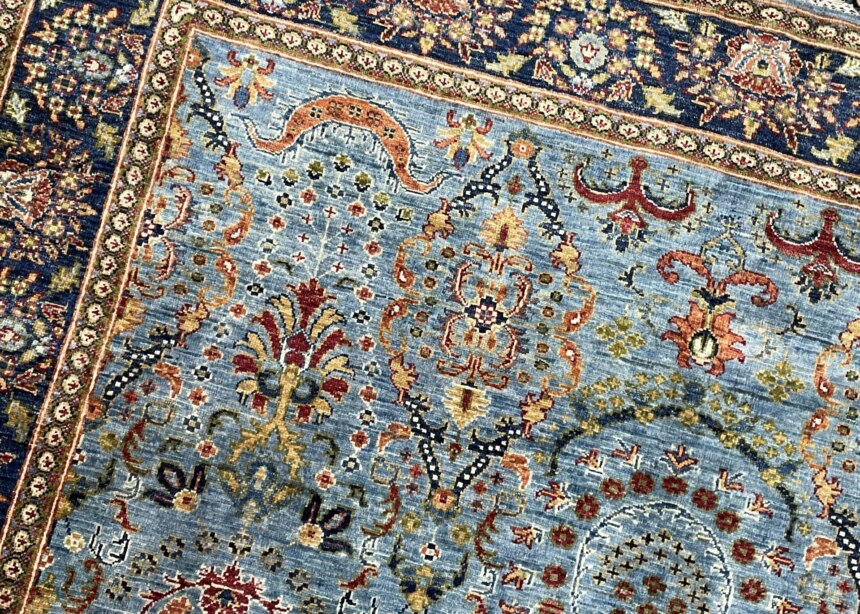
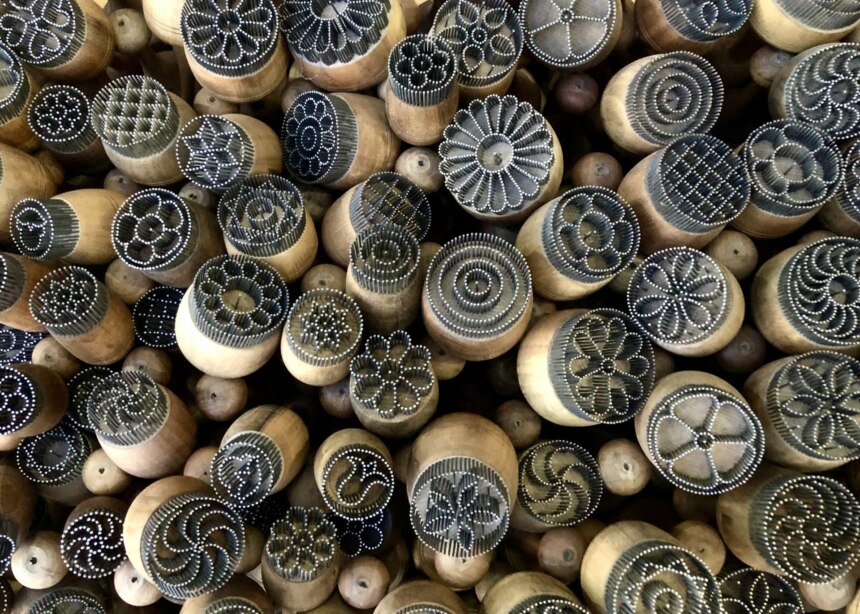
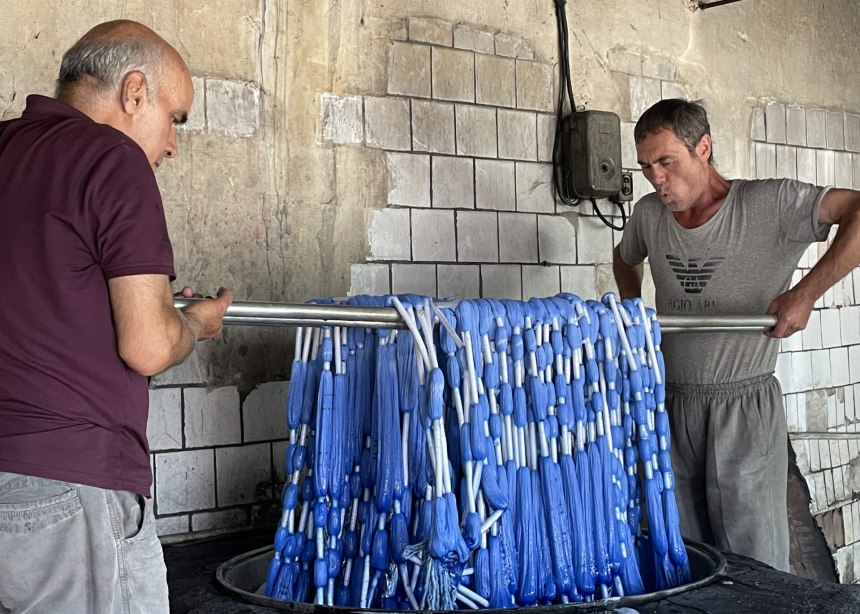
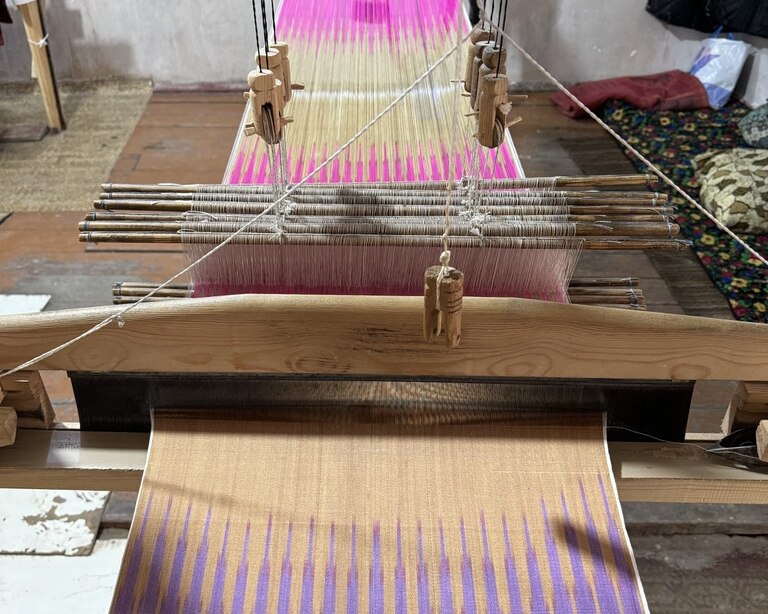
Fergana Valley of Ikat
Next we’ll head for the fabulous Fergana Valley. Along the route, we’ll stop several times, for lunch and to visit to visit the incredible Khudayarkhan Palace.
Then we continue to Margilan, an ancient Fergana Valley city, and home of glowing resist-warp dyed (ikat) fabrics, the most renowned of Uzbek textiles. Margilan town was well-known in antiquity for the superb quality of silk created here. We’ll meet ikat dyers and weavers who are the most skilled in Central Asia. Over the course of our days there, we’ll visit ikat masters to see thread binders, weavers, and dyers. Stunning ceramic plates and bowls will be available at the master ceramicist’s studio we’ll visit. All the pieces are intricately hand-painted.
A highlight will be the local market, another good place to buy inexpensive ikat fabrics which are the most renowned textiles of Uzbekistan. Here you can buy ikat yardage to make robes, quilts or pillows, and other textile treasures, left.
Later we’ll visit an ikat dyeing workshop and will see how the warp threads are bound and dyed in order to make the bold patterns. We’ll visit the Margilan silk factory where we can see the entire process from reeling the silk cocoons to weaving the finished ikat fabric. The shop here has appealing yardage and also scarves, ikat jackets and coats at reasonable prices.
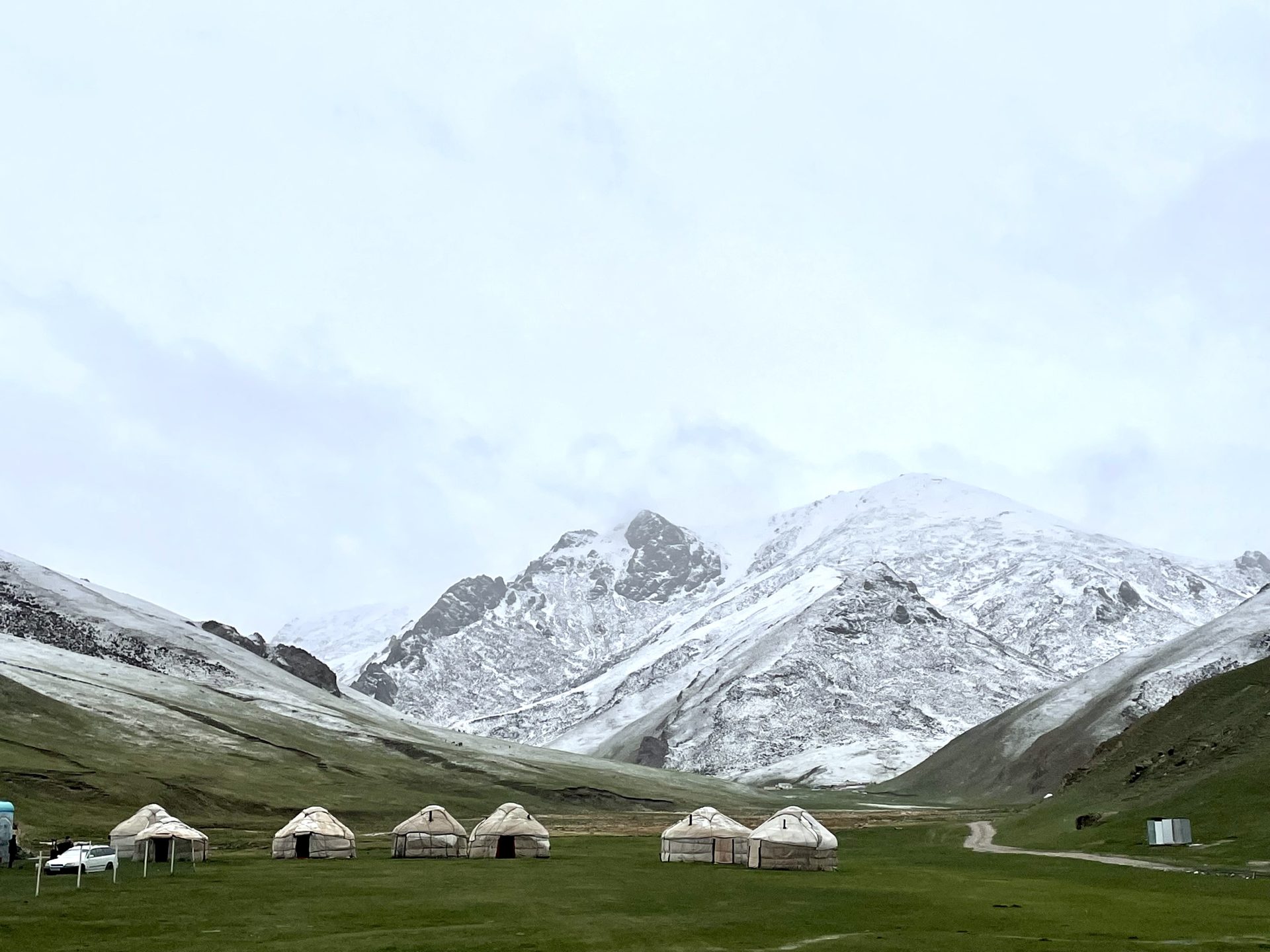
Over the border into Kyrgyzstan
After our time in Uzbekistan, we’ll head over the border into beautiful Kyrgyzstan. Visiting this mountainous and mostly rural country makes a wonderful change of pace after the modern cities and fascinating historical sites of Uzbekistan.
Though long inhabited by a succession of independent tribes, Kyrgyzstan attained sovereignty as a nation-state only after the breakup of the Soviet Union in 1991. Ethnic Kyrgyz make up the majority of the country’s six million people, followed by significant minorities of Uzbeks and Russians.
The few travelers that make it here love the warm-hearted people, peaceful countryside and stunning snow-capped mountain. The capital, Bishkek, is up-to-date with good restaurants and hotels, pretty parks, and a population of one million.
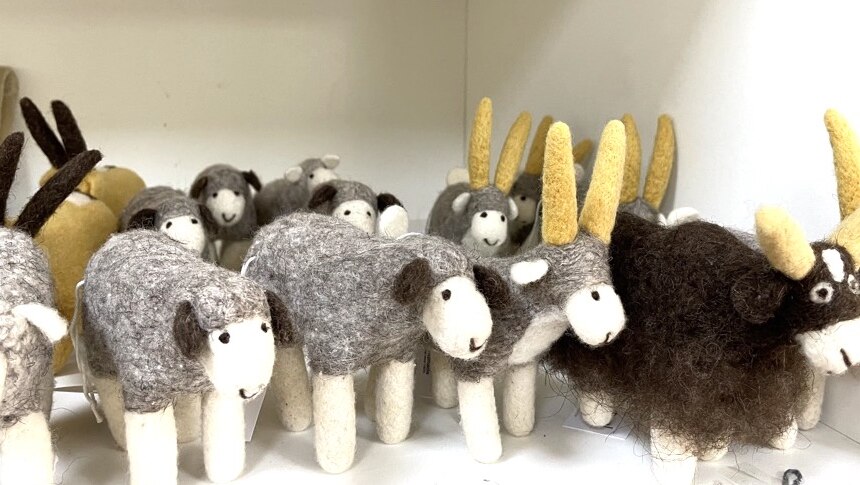
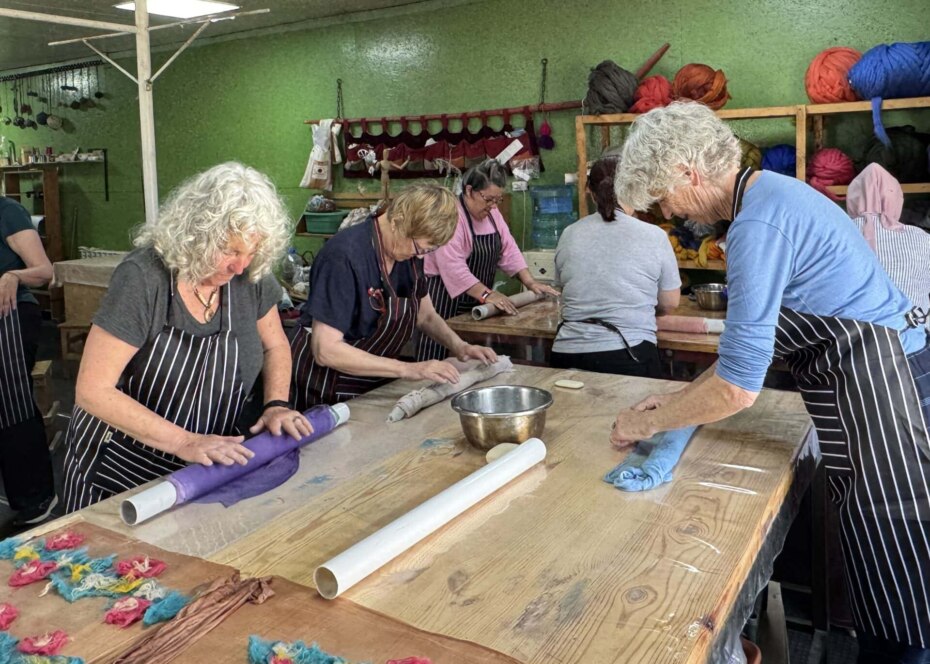
The Beauty of Felt!
We will have a local Kyrgyz specialist guide who will explain Kyrgyz history and culture. Starting in the capital of Bishkek, we’ll visit verdant and peaceful Oak Park and see the ethnographic displays at the nearby National Museum. The bustling Osh Bazaar warrants a visit in case you want a pointy felt cap with earflaps, or a new duffle bag to haul home your pretty felt rug!
We’ll have several opportunities to learn about the renowned Kyrgyz felt-making, in NGO-supported workshops around the country. Best known for making traditional articles such as yurt covers and felted rugs, Kyrgyz artists have innovated and they now also create charming felt toys and clothing such as warm slippers. We will also have a workshop to make a small needle-felted animal like those at left.
We’ll meet a talented Kyrgyz felt artist, learn about her contemporary techniques and see her latest work. We’ll also visit several women’s coops where the felting methods are different. And in our Bishkek workshop, we’ll try our hand at making a wet-felted scarf. You can choose the colors of wool and make shapes to decorate the silk backing, then roll it to perfection. We’ll witness all the different felting techniques as we visit various artisans.
Gorgeous Felted Carpets
Later we’ll drive to Kochkor village, 260 kms from Bishkek. Kochkor is a famous province for sheep farmers and woolen felt makers. We’ll visit the Altyn Kol Women’s Handicraft Co-operative to see their work. And at the Felt Master’s studio, we will learn how nomadic Kyrgyz women make felt rugs called Shyrdak – a floor covering made by cutting positive and negative shapes out of prepared felt, in various brightly dyed colors. Then the positive shapes are inserted into the negative spaces of the background and stitched with a decorative edging, right.
We will see a demonstration of another process of felt carpet making called Ala-kiyiz. This method of layering colored felt shapes on a background, then wetting it, rolling it up and stomping on the roll to bind the wool fibers, is different from the modern felt carpets with the cutout shapes that we have seen before.
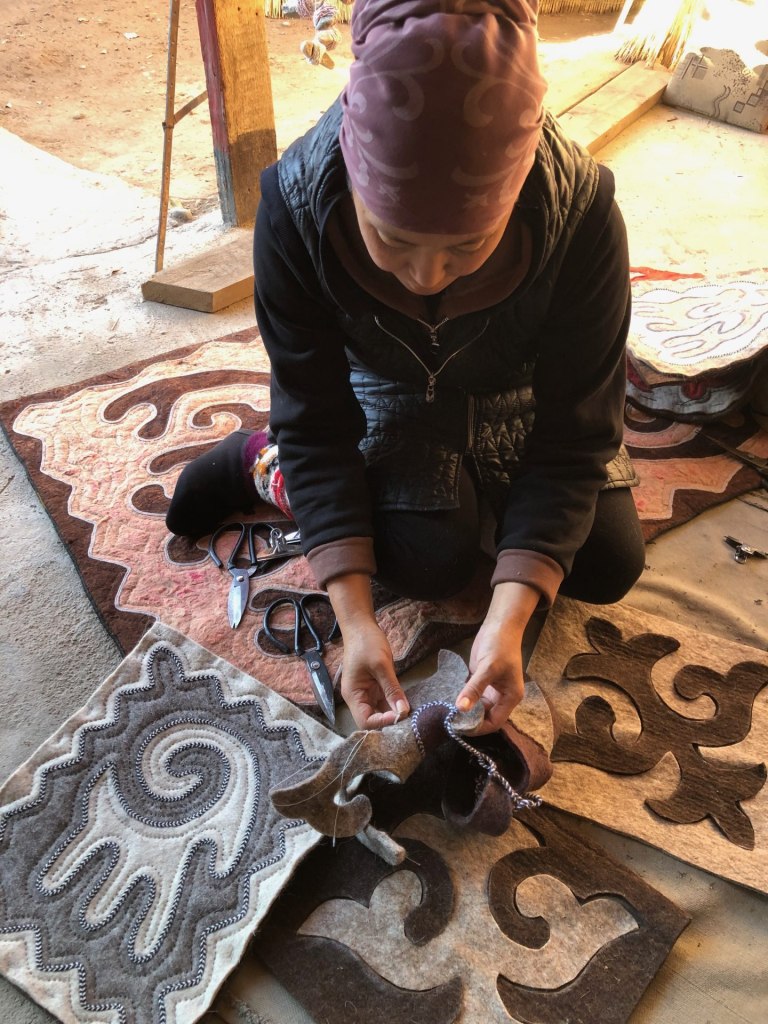
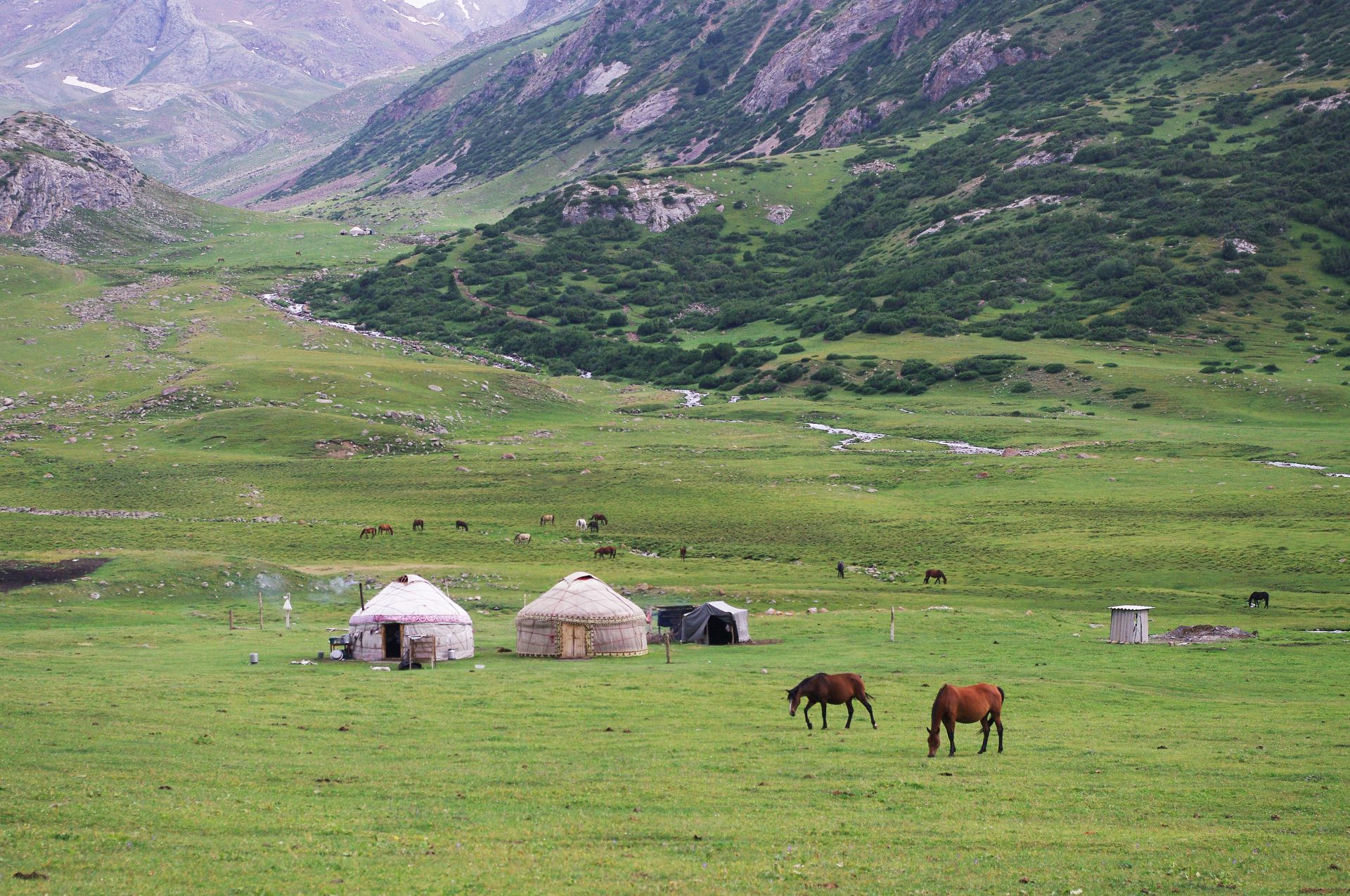
Tian-Shan Mountains
One day we’ll drive along another part of the Great Silk Road to the Tash-Rabat Caravanserai. This trip passes through the spectacular mountains and valleys of the Tian-Shan mountains where we will enjoy stunning views of the At-Bashy ranges.
The well-preserved 15th century stone building of Tash Rabat stands 100 km before the Kyrgyz-Chinese border at Torugart, at 3500 meters altitude. It has a central hall and 30-odd small rooms. At nighttime, traveling Silk Road merchants and their camels took shelter in caravanserai from bandits and the cold.
The Tash-Rabat region is spectacular. High mountains are dotted with Golden Marmots observing the scene from in front of their burrows. Shaggy near-wild horses and dark brown/white yak roam the picturesque hills.
We’ll spend a peaceful night at the yurt camp near the enormous IssyKul Lake. Two or three other friends will share your yurt, which has ‘real’ beds with lots of covers. You’ll have western toilets/showers/sinks very close to each yurt, for your convenience.
On to Karakol
Next morning, we’ll continue to Kyzyl-Tuu village where a Kyrgyz master yurt maker will show us how to assemble a felt-sided traditional yurt, without metal or nails.
A traditional eagle hunter will demonstrate his Golden Eagle’s skill by letting the eagle loose to chase and snag a goatskin with a chunk of meat attached (no animals harmed in the demo). We’ll learn about the tradition of hunting with eagles. The Master will explain how the eagles are trained to hunt and how they helped save the nomadic population from starvation over harsh winters. The close bond between the eagle and her Master is fascinating.
We’ll continue to Karakol. Karakol town, one the first Russian military outposts, was founded in 1869. Here we can walk around to see the wooden Russian Orthodox church called the Holy Trinity Cathedral, still used for services. There is also a most unusual pagoda-styled Chinese mosque with complex cut woodwork decorations under the eaves.
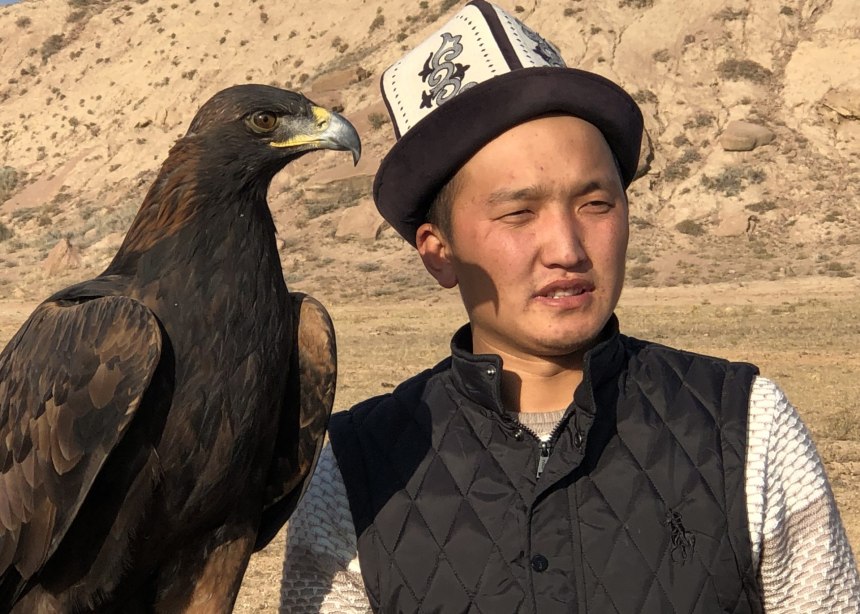
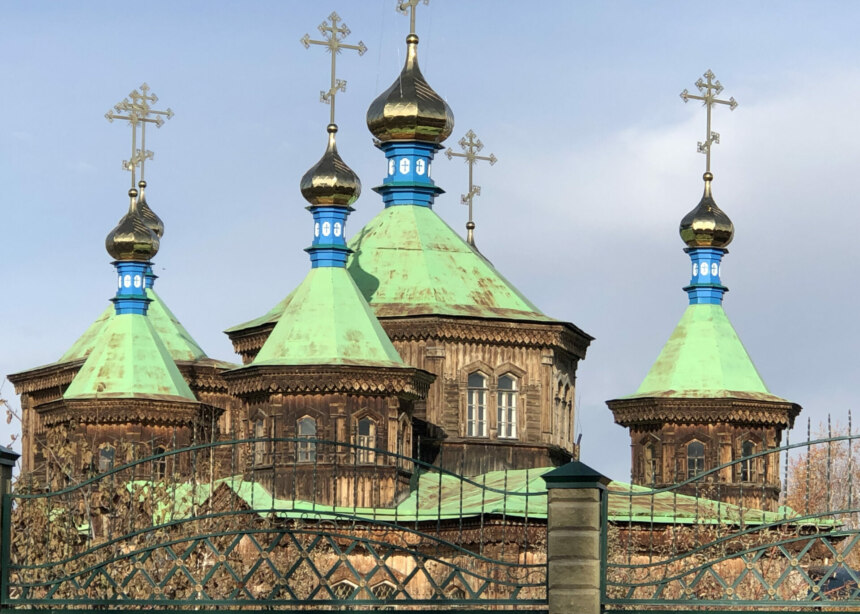
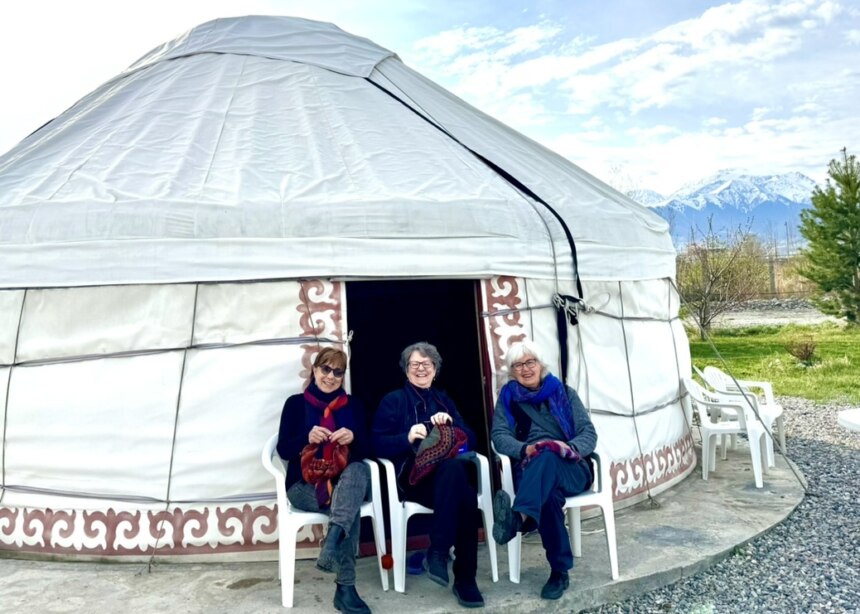
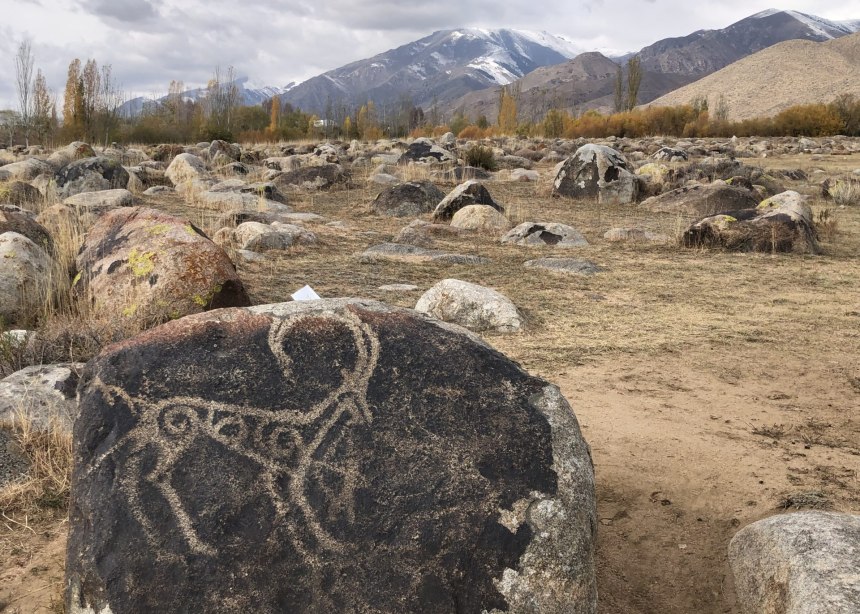
Winding it up with Music…
And on our last night in the rural countryside, we’ll have a delicious dinner at a Uighur family home, with an interesting Kyrgyz musicians’ folk concert. The talented and welcoming musicians will explain their unique handmade instruments too.
Then next day, on our way back to Bishkek we’ll stop to see the enormous field of boulders with ancient rock engravings at Cholpon-Ata’s open-air museum. With a splendid background made of high snowy mountains, this collection of petroglyphs dates back more than 4,000 years.
This open-air museum is a very important historical site, located on a territory of 42 ha (104 acres) with hundreds of petroglyphs (images carved or ‘pecked’ onto stones).
At the end of our adventure, after seeing gorgeous suzanis, stunning ikat yardage and beautiful felt rugs, we’ll return to Bishkek. The afternoon is free to relax and pack up your treasures. Our Farewell Dinner is tonight! We’ll spend the last night back in Bishkek and then fly home from Bishkek the next morning.
Some of our Hotels…

Hotel StayInn, Tashkent
A new hotel with spacious and com-fortable rooms with smooth linens, excellent beds, and contemporary bathrooms. The breakfast buffet is plentiful, with many choices. StayInn is located in a quiet residential neighbor-hood, with a good supermarket a block away.
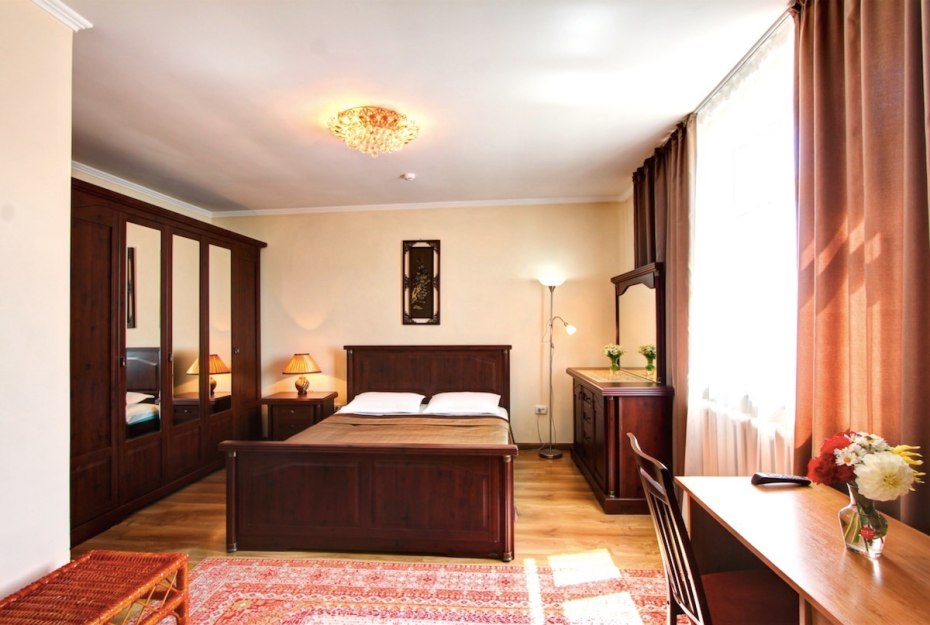
Green Yard Hotel, Karakol
Large and light-filled modern hotel surrounded by pleasant gardens and fruit trees. It has comfortable rooms and a spacious, sun-flled dining room. Breakfasts are delicious and huge, with many choices. The owner and staff are all helpful and very welcoming.
Additional Details & Experiences
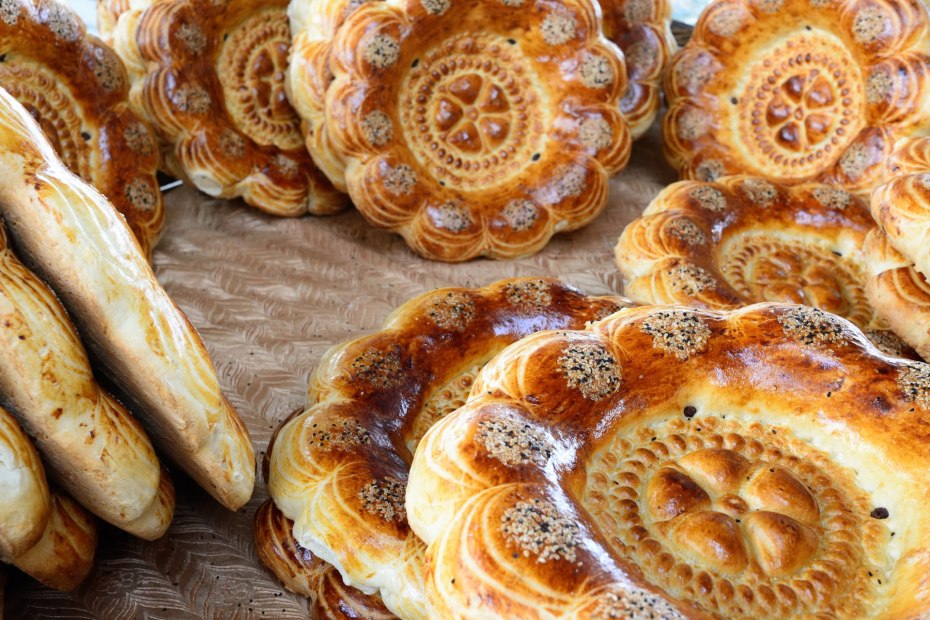
Bread In Uzbekistan
Bread is considered sacred by Uzbek people and is not to be wasted. The traditional round and flat bread, called non or patir, is slapped on the fiery hot walls of a tandoor (round clay oven) to bake. Then it comes out toasted and crispy. Loaves are decorated with spiked bread stamps in different patterns. Bread of each region has its own particular method of leavening, its own baking techniques and its own inimitable taste. For instance, delicious flaky bread – katlama non – typifies the Fergana Valley version. Some yummy breads called lepeshkas are prepared with onion or meat baked inside the dough.

What are the traditional foods of Uzbekistan?
We’ll eat delicious food everywhere and learn about the local cuisine in at least one cooking class. Popular foods include vegetable, chicken or beef skewers, fresh salads and dishes such as pilaf or plov, with beef or lamb.
Meat-filled pastries called samosas are common too. Vegetarians will have no trouble at all; many salads such as grated carrots or beets with walnuts, or tomato, arugula, burrata and cucumber are popular and found in many restaurants. Vegetarian soups like cold cucumber and yogurt are popular too,
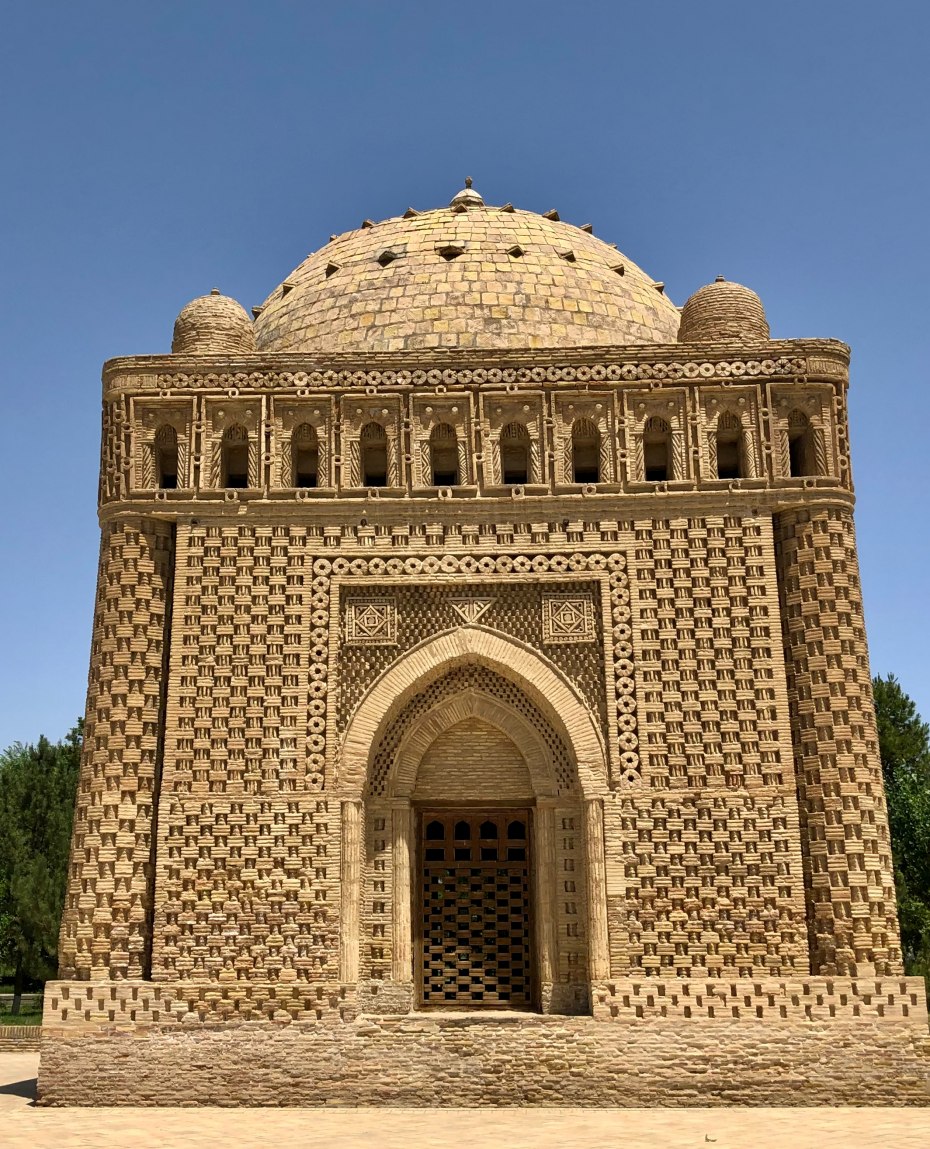
The Ismail Samani Mausoleum
The Samanid Mausoleum is an architectural wonder, a perfect cube of tan bricks, with decorative basket-weave brickwork patterns inside and out. It’s located in the northwestern part of Bukhara, just outside its historic center. It was built in the 9th-10th centuries AD as the resting place of the powerful and influential Islamic Samanid dynasty. The mausoleum is extremely important from an art historical perspective as it is the earliest instance of an Islamic tomb to survive in Central Asia. It’s also a rare example of decorating a structure with unglazed bricks arranged in intricate patterns.
Your Trip Leader and Guides
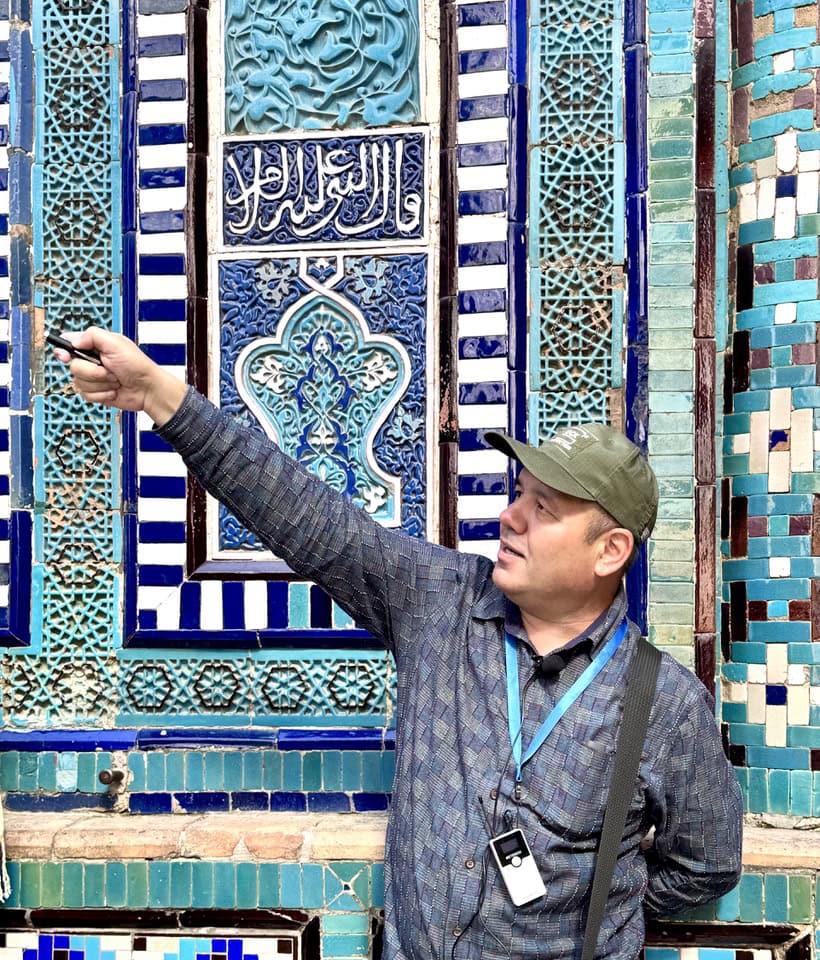
Mirza
Mirza taught English at the Tashkent Law College before becoming a professional guide in 2006. His easy-going personality and infinite patience are a large part of why trips with him are so delightful. He explains just the right amount of the complicated history of his country and its architecture. He’s also friends with many of the textile and ceramic artisans and understands their working techniques, which makes those encounters more personal and interesting.
Cynthia also will accompany this September 2025 trip.
A professional guide, expert in textiles, arts and culture of his or her respective country (Uzbekistan or Kyrgyzstan), will accompany the itinerary. These guides speak English, Uzbek, Kyrgyz and Russian!
Check Trip Availability
Trip signups are accepted on a first-come, first serve basis. Please provide your details below and we’ll be in touch to confirm whether spaces are still available for this trip. If you need to get in contact, please email: info@btsadventures.com
Registration Information
- Dates: Sept. 9 – Oct. 1, 2025
- Fly Home Date: October 2, 2025
- Deposit: $500
- Tour Cost: 24 Nights for $6,520
- Single Supplement: $750
For more information:
Phone: 707-939-8874
E-mail: info@btsadventures.com
Read: Frequently Asked Questions
Travel Plans
Fly into Istanbul on Turkish Airlines and connect with Turkish to Tashkent flight, arriving on September 9 at 7am. There is also a Turkish Airlines flight that arrives at 1am on September 9. Either flight is OK and you will be picked up at the TASHKENT airport (TAS) whenever you arrive.
Most people fly into Istanbul from their home airport, then connect with Turkish Airlines for the flight to Tashkent (TAS), Uzbekistan.
For Americans living in cities served by Turkish Air, it will be less expensive to take Turkish Airlines for the whole flight itinerary. Turkish flies non-stop to IST from US cities such as SFO, LAX, SEA, and others.
You will fly into Tashkent on September 9, then fly home from BISHKEK (FRU) at the end, on October 2. You will most likely be in the air on September 8, and the hotel is reserved for your arrival that night/morning of the 9th so you don’t have to wait until check-in on the 9th to enter your room.
Visas
If you are over 55 years old, a visa for Uzbekistan is no longer necessary, as of May 1, 2022. If you are under 55 you will need to apply through the government’s website; we’ll send the link if this is your case.
Right now, Kyrgyzstan doesn’t require any visa for foreign travelers from the USA, Canada, Australia, UK, Turkey and most of Europe. The list includes many more visa-free countries, and citizens of other countries can apply for an e-visa online. We will send you the latest visa info and will let you know if the above policy changes.
What’s Included
- 24 nights of accommodation in double rooms with private bathrooms, possible one-night shared yurts, and possible one-night homestay in Kyrgyzstan. Single rooms available with supplement.
- Expert Uzbek English-speaking professional guide
- Expert Kyrgyz English-speaking professional guide
- Textile expert Cynthia Samaké to accompany tour.
- All breakfasts in the hotels included
- All lunches and dinners included, except 2 meals which will be on your own
- Transportation by air-conditioned Minibus
- Entrance fees to all sites and monuments
- 2 Flights: from Urgench (Khiva) to Tashkent and flight from Osh to Bishkek.
- All Tashkent and Bishkek airport transfers
- Train travel between Tashkent and Samarkand, Samarkand and Bukhara – and all train station transfers.
- Private mini-bus to Khiva with our professional driver
- Bottled water on all van rides and in most hotel rooms; you can buy more if needed.
- Silk and felt scarf workshop; Felt-making demonstration.
- Ikat warp tying, dyeing and weaving demonstrations.
- Wood Block printing demonstration.
What’s Not Included
- International flights
- Visa and passport fees
- 2 Dinners (buy fruit and cheese picnic to eat at the hotel, or go out on your own)
- Tips for guide and driver; amounts will be suggested
- Recommended travel/trip cancellation insurance (suggestions about this later)
Frequently Asked Questions
General Questions
What information will I receive after registering?
Once you sign up for a trip, we will e-mail a general itinerary, lists of Suggested Reading, what to take, cultural considerations, weather charts, etc.
How can I get a detailed itinerary for a tour?
A day-to-day itinerary will be sent once you sign up for a trip. If you need specific information about the flow of the trip and the pace of the specific activities, before committing to the trip, get in touch with your questions and we will be happy to fill you in.
What sort of clothing should I bring?
When you sign up for a tour, you’ll receive detailed lists of what to bring to your destination, as well as weather info, to more easily coordinate your wardrobe with the heat or cold.
Your travel clothing will depend on the weather during your stay, in either May or October. We’ll send a list of weather/temperatures to help you decide on comfort levels, but modest clothing is important at all times. In Kyrgyzstan, we’ll be visiting rural, casual destinations and you will need sturdy shoes for walking around the archeological sites. Bring a walking stick if it might help you walk over rough mountain terrain; we will not be trekking but strolling… over the field of boulders with the petroglyphs, for instance.
Are laundry services available?
Most hotels have a laundry service and prefer that you don’t wash clothes in the bathroom sinks. If there is no laundry service, and you don’t want to wash your jeans and wait a day or two for them to dry, asking at the hotel desk is a good place to start.
Please note that it is considered demeaning to wash someone else’s underpants, so we ask that you wash your own underpants. Hang them to dry discreetly in the bathroom.
Are laundry services available?
Most hotels have a laundry service and prefer that you don’t wash clothes in the bathroom sinks. If there is no laundry service, and you don’t want to wash your jeans and wait a day or two for them to dry, asking at the hotel desk is a good place to start.
Please note that it is considered demeaning to wash someone else’s underpants, so we ask that you wash your own underpants. Hang them to dry discreetly in the bathroom.
Are laundry services available?
Most hotels have a laundry service and prefer that you don’t wash clothes in the bathroom sinks. If there is no laundry service, and you don’t want to wash your jeans and wait a day or two for them to dry, asking at the hotel desk is a good place to start.
Please note that it is considered demeaning to wash someone else’s underpants, so we ask that you wash your own underpants. Hang them to dry discreetly in the bathroom.
Do I need any vaccinations or immunizations?
This varies with each country. Make an appointment with your travel doctor/clinic and take your tour itinerary with you. Some areas of certain countries require malaria pills and others do not; same with Yellow Fever and others, such as Cholera and Typhoid. The travel nurse or physician will have all the latest requirements at hand.
OR You can consult the CDC.gov (Center for Disease Control) website information pages for your specific destination so that you have the latest official information.
For all travel, you should be current on your typical childhood and international travel shots such as Polio and Tetanus. Some countries require proof of Yellow Fever vaccination for entry, if you are coming from a country that has yellow fever.
Behind the Scenes Adventures requires you to have had at least two COVID vaccinations. We won’t ask for proof; this requirement is on the Honor System. We recommend you have all available boosters as well.
How much physical activity is involved during the trip?
Each trip has different activity levels that will be fully explained in the specific tour material. But no activities or events are mandatory, and you are always welcome to sit at the bottom of the stairs to a temple or wait in the van while others ascend or visit a particular place. Walking sticks are fine to bring if they help you. We cannot accept wheelchairs or walkers.
For most tours, you’ll need to be able to walk the distance of 4-5 city blocks on your own, with sturdy shoes. Please note that sidewalks in many countries are full of big holes and broken cement chunks, with bits of re-bar sticking out, and you must constantly be alert to these dangers. In urban areas where distances are greater, the group will take taxis and/or get help from local assistants. If you need a personal taxi or additional special aid, that will be at your expense.
What will the weather be like?
Our Uzbekistan trips are planned for temperate weather with little or no rain, in April-May and September-October. Summer temperatures are far too hot! Average daytime temperatures are usually in the 70s and nights can be cooler, in the 50s. With global warming, it is much harder to predict but we will send Weather Charts with your pre-departure info.
What kind of electrical adapter will I need?
You will need little adapters for our typical flat-pronged plugs that make them fit the round sockets below. Find these at any travel store, online individually (from you-know-who), or as a set, or at Target, etc. You will need them since most hotels and riads have only sockets that accept round prongs.
NOTE that these are not converters; they do not step down the 220v. electricity. Be sure all your chargers and hair dryers, etc. say INPUT: 110 to 220 or 240 v.
Most chargers now say INPUT: 110 to 220 or 240 volts; many hair dryers do not, and you will fry the device if plugged in without a converter. They are larger and more expensive than adapters; get dual-current devices instead of needing a converter. I never travel with a converter, but things like C-pap machines might require one. Better yet, find a hair style that doesn’t need a dryer, LOL.
Type E

- Primarily used in France, Belgium, Poland, Slovakia & the Czech Republic AND MOROCCO, etc.
- 2 ROUND pins, grounded
- 16 A
- 220 – 240 V socket compatible with plug types C, E & F
Type C

- MORE COMMON than above version, not grounded
- Commonly used in Europe, South America & Asia
- 2 round pins, skinnier than Type E
- 2.5 A — almost always 220 – 240 V
- Socket compatible with plug type C
Meals & Accommodations
What sort of hotels will we be staying in?
Hotels that we choose in Uzbekistan are usually in traditional style with carved wood decor, typically new and up-to-date. Our hotel in Tashkent is semi-ttraditional, with comfortable, well-lit rooms, good beds and linens. It has modern bathrooms, a good restaurant at lobby level, and an elevator. The hotel in Samarkand is more modest. The new, private, homestay in Margilan belongs to the family of the most famous ikat weavers; it’s a treat to stay there, surrounded by textiles! Before we depart, we will send you a list of all hotels with contact information in case someone at home needs to contact you.
What kind of money will we be using?
Purchases are made either in local money, Uzbek SOM for example, or in US dollars. US dollars are stable and the most widely accepted foreign currency, and they are what you should bring. Euros are also accepted. Canadian dollars are not often accepted so you are safer with US dollars. Other currencies are either not accepted, or the rates are not correctly calculated.
Bring US dollars in clean, new-ish, unmarked, unripped bills. $100 bills are fine, but you could bring about a dozen $20s also just in case you want to buy smaller items, in places that accept dollars. I will hand out currency exchange charts when we meet.Purchases are made either in local money, Uzbek SOM for example, or in US dollars. US dollars are stable and the most widely accepted foreign currency, and they are what you should bring. Euros are also accepted. Canadian dollars are not often accepted so you are safer with US dollars. Other currencies are either not accepted, or the rates are not correctly calculated. Bring US dollars in clean, new-ish, unmarked, unripped bills. $100 bills are fine, but you could bring about a dozen $20s also just in case you want to buy smaller items, in places that accept dollars. I will hand out currency exchange charts when we meet.
Do NOT count on using ATMs, although their service is much better nowadays. They exist but can be out of money, or the systems are down, etc.
Credit cards might be accepted for large purchases with a surcharge at more modern shops, but definitely will not be accepted for small items in markets, and small shops.
It’s easy! BRING plenty of CASH dollars, and just take home what you don’t spend. You will keep your US bills in your secret waist pouch or your wallet. You can lock extra money inside your suitcase in the hotel also; we know and trust the hotels where we stay.
How do I change money to buy textiles and other items if I need local money?
We will go as a group to a currency exchange place when we arrive in each country, to change our clean, new-ish, unmarked, unripped US dollar bills into SOM or other local currency. Some places that we shop will accept dollars or credit cards but since there is a high fee for them, merchants greatly prefer cash – dollars or local money.
How much money should I bring for the trip?
Since your trip fee includes all the necessities, you will need spending money only for alcoholic drinks, guide and driver tips, and textiles and souvenirs that you decide to buy.
There are many exciting and beautiful textiles, yardage, and fashionable clothes to take home with you! Bring as much cash as you can afford to spend, or that you’ve budgeted for, and plan on using a credit card for any large unplanned purchases like rugs or vintage suzanis. You can always return to the US with any extra, un-spent dollars.
What sort of food will we be eating?
Uzbek food is fresh and delicious. There is an excellent variety of salads without lettuce, including grated carrots, beets, and other fresh choices. Chicken or beef kebabs are popular and delicious. There are some good hot and cold soups, such as a cold yogurt and cucumber version, so refreshing in warmer months. Lagman is a delicious thick noodle soup with bits of beef.
Other popular dishes are samosas, meat or vegetable-filled pies baked in a round tandoor oven, and the Uzbek national dish called Plov. Typical blue-collar lunch plov mixtures served from huge cauldrons are greasy but other healthier and delicious plov versions include lots of yellow and orange carrots, garbanzos, and raisins. Uzbekistan is famous for fresh-baked bread and bakeries. Every meal starts with fresh bread, sometimes with grilled onions incorporated (my favorite!).
Will I be able to accommodate my dietary needs?
If you have any special dietary, health, or nutrition issues, restrictions, etc, there is no guarantee that
Behind the Scenes Adventures will be able to accommodate your special diets in foreign countries.
Please contact us before departure, and bring sufficient alternative foods. Travelers with severe peanut allergies or other life-threatening allergies cannot be accepted. Vegan diets are possible but with much less variety than at home. Vegetarian or gluten-free diets are often fairly easy to accommodate, but also with less variety than what is available at home. Note that the guide and tour leader cannot cater to your special diet in a group; you’ll be responsible for choosing foods you can eat.
Flights & Travel
Will I need a visa for connecting countries?
It is very rare to need a visa for a connection if you stay in the Transit area. This will be regulated by the connecting country and the airline will send information as to this requirement.
Will I be met at the airport?
Yes! A driver (and the guide if possible) will meet you with a sign – beariing your name and/or Behind the Scenes Adventures. The driver will have your flight schedule and he will know that you need time to pick up your luggage. Wait for him in the terminal, right outside the Arrivals area, and don’t go with any other drivers that don’t have your name on a placard.
For each trip, we’ll send more specific info about the exact pick-up spot. The driver will help with your luggage and a small tip of $5 USD would be appreciated anywhere..
What are the requirements for my passport to be valid?
Your passport needs to have one blank page for your visa, although, with an E-Visa, you will have just a piece of paper to show, and don’t need room for anything except Immigration stamps in your passport.
What is the best airline to fly to the country?
Turkish Airlines is the easiest, depending on where you live….You will need to get to Istanbul, Turkey, then connect to Tashkent. There are non-stop flights to Istanbul’s fabulous new airport (code IST) from SFO and LAX, and perhaps other major cities. Try to get a non-stop flight; it’s much easier not to have to change planes. Some flights connect in Istanbul for an hour or two, then continue directly to Tashkent – easy!
I found good deals on Expedia.com with Turkish Airlines which is very good; they are a partner of United. Turkish and United are the airlines I always use but from your home airport, there may be other deals with other airlines such as Delta and Air France, etc.
What will we use for transportation?
We use a Mercedes Sprinter for most interior transportation. It is high-topped and spacious, and our luggage is stored in the back, or on top if we amass extra bags along the way. (This is another reason we must start with a luggage limit.)
With a small group, we may use a Chevrolet SUV (made in Uzbekistan!) for the whole trip. Vans and buses are not allowed on the route from Tashkent to Ferghana Valley, so we will go in Chevy SUVs. And we will take the modern high-speed train, from Tashkent to Samarkand and on to Bukhara.
We will also fly on two interior/domestic flights.
- Dates: Sept. 9 – Oct. 1, 2025
- Fly Home Date: October 2, 2025
- Deposit: $500
- Tour Cost: 24 Nights for $6,520
- Single Supplement: $750
